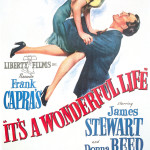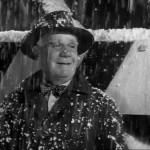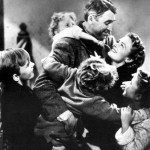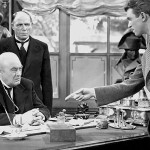“Every time a bell rings, an angel gets his wings”
I’ve been asked before now why I consistently rate this movie among my all-time top favourites. Non-admirers would call it mawkish, sentimental, typical American schmaltz telling of a chocolate box world that never existed, and certainly not helped by the references to afterlife and angels.
Well, Frank Capra‘s It’s A Wonderful Life always makes me wipe away a tear, no matter how many times I watch it, but is none the worse for that. The reason is simple: this is a movie about karma, about the good guy, the one who helps people while sacrificing his own needs and desires, ultimately winning out at his time of greatest need, simply because people remember all he did for them when they needed help. This is the ultimate parable to demonstrate the value of believing in yourself and doing good.
True, there’s no doubt you have to suspend disbelief and accept that a certain proportion of this allegorical tale set in fictional small town America is fantasy, but since it conveys a message of hope and goodwill – that no matter how bad things seem, they could be much worse, and may soon be very much better – you can forgive a lot. In fact, what you see is the good karma of George Bailey being rewarded for all the many good things he has done in his life.
But while this may be the ultimate feelgood movie in many eyes, it’s actually much more than that, exploring some of the deep dark places in the American dream that people would sooner pretend never existed, without ever going into the underbelly in more than superficial detail. The happy ending is inevitable, in spite of how close George comes to killing himself – a thin line between life and death?
What makes IAWL so charming and repeatedly watchable is the brilliance of Jimmy Stewart as the good-natured everyman who sacrifices his own future to take over his father’s home loan friendly society in the perfect town – Bedford Falls, New York. Stewart always had the ability to make a character likeable, without ever disguising their flaws and dark side. He imbues George Bailey with a down-to-earth homely vulnerable charm, a man with man y regrets, self-d0ubts and human frailties, not to mention a temper and a passion – perfect he ain’t, but nonetheless, or maybe as a direct consequence we recognise also his virtues as a good family man who thinks of others before himself and harbours regrets.
In this context he represents the ordinary guy against the thieving, grasping evil of pure capitalism in the form of old man Potter, a character who might in other movies represent the thriving but soulless industry of American free market economics. Here, the hero is the decent, honest guy trying to make a small scale living against the odds, who wishes only good to his friends and neighbours, and they ultimately help him. Surprising in one sense this was not regarded in McCarthyite America as a communist conspiracy; maybe it was?
But then there are the religious overtones, the presence of an angel to demonstrate the value of good and evil. Clarence is by no means your standard image of an angel, but then he might be regarded more as a conscience in the same way as Jiminy Cricket in Pinocchio. And in a strange way, this is almost a live action version of the cartoon, as Clarence encourages George to wish upon a star by imagining how the world would have looked had he never existed, but then to look upon it in a totally different light.
In that sense, we could all do with a Clarence to help us see the positive flipside of everything. In truth, the religious content is a red herring, doubtless one which pleases hometown America, but the heart of the movie is a human tale, one in which we cope with adversity and try to bounce back against those who would seek to destroy us, though our loyal family, friends and community are the people on whom we must depend, and they on us. You don’t have to read the subtext here though. Just enjoy IAWL at face value for what it is – a wonderful movie in, despite everything, a wonderful life, and to demonstrate the impact it has made read this from Wikipedia:
It’s a Wonderful Life premiered at the Globe Theatre in New York on December 20, 1946, to mixed reviews. While Capra considered the contemporary critical reviews to be either universally negative or at best dismissive, Time said, “It’s a Wonderful Life is a pretty wonderful movie. It has only one formidable rival (Goldwyn’s The Best Years of Our Lives) as Hollywood’s best picture of the year. Director Capra’s inventiveness, humor and affection for human beings keep it glowing with life and excitement.”
Bosley Crowther, writing for The New York Times, complimented some of the actors, including Stewart and Reed, but concluded that “the weakness of this picture, from this reviewer’s point of view, is the sentimentality of it—its illusory concept of life. Mr. Capra’s nice people are charming, his small town is a quite beguiling place and his pattern for solving problems is most optimistic and facile. But somehow they all resemble theatrical attitudes rather than average realities.”
The film, which went into general release on January 7, 1947, placed 26th ($3.3 million) in box office revenues for 1947 (out of more than 400 features released), one place ahead of another Christmas film, Miracle on 34th Street. The film was supposed to be released in January 1947, but was moved up to December 1946 to make it eligible for the 1946 Academy Awards. This move was seen as worse for the film, as 1947 did not have quite the stiff competition as 1946. If it had entered the 1947 Awards, its biggest competition would have been Miracle On 34th Street. The number one grossing movie of 1947, The Best Years of Our Lives, made $11.5 million. The film recorded a loss of $525,000 at the box office for RKO.
On May 26, 1947, the FBI issued a memo stating “With regard to the picture “It’s a Wonderful Life”, [redacted] stated in substance that the film represented rather obvious attempts to discredit bankers by casting Lionel Barrymore as a ‘scrooge-type’ so that he would be the most hated man in the picture. This, according to these sources, is a common trick used by Communists. [In] addition, [redacted] stated that, in his opinion, this picture deliberately maligned the upper class, attempting to show the people who had money were mean and despicable characters.”
In an interview with Michael Parkinson in 1973, Jimmy Stewart declared that out of all the movies he had made, It’s a Wonderful Life was his favorite.
In 1990, It’s a Wonderful Life was deemed “culturally, historically, or aesthetically significant” by the United States Library of Congress and selected for preservation in their National Film Registry.
In 2002, Britain’s Channel 4 ranked It’s a Wonderful Life as the seventh greatest film ever made in its poll “The 100 Greatest Films” and in 2006, the film reached No. 37 in the same channel’s “100 Greatest Family Films”.
In June 2008, AFI revealed its 10 Top 10, the best ten films in ten “classic” American film genres, after polling over 1,500 people from the creative community. It’s a Wonderful Life was acknowledged as the third-best film in the fantasy genre.
Somewhat more iconoclastic views of the film and its content are occasionally expressed. In 1947, film critic Manny Farber wrote, “To make his points [Capra] always takes an easy, simple-minded path that doesn’t give much credit to the intelligence of the audience”, and adds that there are only a “few unsentimental moments here and there.” Wendell Jamieson, in a 2008 article for The New York Times which was generally positive in its analysis of the film, noted that far from being simply a sweet sentimental story, it “is a terrifying, asphyxiating story about growing up and relinquishing your dreams, of seeing your father driven to the grave before his time, of living among bitter, small-minded people. It is a story of being trapped, of compromising, of watching others move ahead and away, of becoming so filled with rage that you verbally abuse your children, their teacher and your oppressively perfect wife.”
In a 2010 Salon.com piece, Richard Cohen described It’s a Wonderful Life as “the most terrifying Hollywood film ever made”. In the “Pottersville” sequence, he wrote, George is not “seeing the world that would exist had he never been born”, but rather “the world as it does exist, in his time and also in our own.” Nine years earlier, another Salon writer, Gary Kamiya, had expressed the opposing view that “Pottersville rocks!“, adding, “The gauzy, Currier-and-Ives veil Capra drapes over Bedford Falls has prevented viewers from grasping what a tiresome and, frankly, toxic environment it is… We all live in Pottersville now.”
The film’s elevation to the status of a beloved classic came decades after its initial release, when it became a television staple during Christmas season in the late 1970s. This came as a welcome surprise to Frank Capra and others involved with its production. “It’s the damnedest thing I’ve ever seen,” Capra told the Wall Street Journal in 1984. “The film has a life of its own now, and I can look at it like I had nothing to do with it. I’m like a parent whose kid grows up to be president. I’m proud… but it’s the kid who did the work. I didn’t even think of it as a Christmas story when I first ran across it. I just liked the idea.” In a 1946 interview, Capra described the film’s theme as “the individual’s belief in himself” and that he made it “to combat a modern trend toward atheism“.
The film’s popularity continues, and it currently holds an 8.7 out of 10 rating on the IMDb consumer reviews and a 93% “Fresh” rating on Rotten Tomatoes.
A quick word about the cast, since this is far from a Stewart one-man show. Some are sketched lightly but still the cameos stand out, with special mention to Donna Reed as George’s wife and emotional counterpoint, Mary, plus the deliciously evil Lionel Barrymore as pantomime villain, Henry F Potter. You can’t fail to enjoy any of them!













